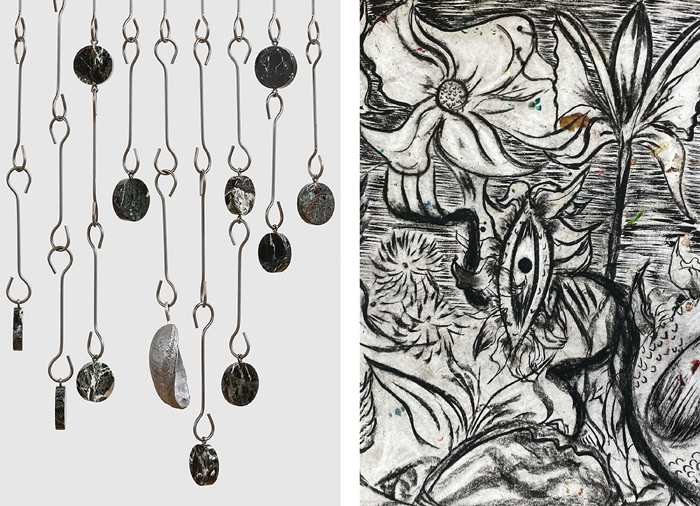
Shulamit Nazarian is pleased to announce Seeds, a two-person exhibition featuring the works of Los Angeles artists Fay Ray and Daniel Gibson, on view from April 8 through May 13.
Joining Ray’s suspended sculptures with Gibson’s mixed-media works on paper, Seeds unites two gallery artists for their congruous approaches to the desert landscapes of Southern California. Harvesting desert imagery for alternative methods to represent the body, these artists reference the natural world to address socio-cultural experiences, unearthing a liberated state of being that exists within all.
Linking weathered aluminum sheets with precious stones, wire, chain, and cast-aluminum desert objects into suspended sculptural masses, Fay Ray’s visual vocabulary explores her familial and religious roots relative to the fetishization of objects and the construction of female identity. Returning to the High Desert in Southern California where she grew up, she collects a variety of materials intimately linked to her past, giving equal attention to the industrial trucking equipment and metal scraps of her family’s multi-generational agricultural trade and to the corn, cacti, agave, and seashells found naturally in the desert landscape. Representative of labor and harmony with nature, the artifacts are imbued with a human touch. Cast in aluminum, Ray joins these amulets to sheet metal with individually-formed chain links, borrowing their hand-fastened structure from the compositions of religious relics and the visual language of the occult. Shifting between specificity and mystery, Ray’s artworks embrace ambiguity as the realm of endless potential.
In addition to the California desert’s relations to migration and labor, Ray also looks to the materials of the desert landscape for their symbolic power relative to femininity, fertility, and motherhood, enlisting a systematic organization of abstract form to evoke a continually materializing body. By shifting the experience of the work between visibility and invisibility, the artist embraces the primary mode of desert ecosystems. Indicating the potential for abundance in its apparent absence, the compositions are in a perpetual dance with the concept of expansion and contraction, the fundamental cycle of all living things. The suspended and wall-mounted artworks resemble an oversized body adornment, such as a necklace, earring, or keychain, implying the invisible presence of a massive being to whom they may be offered. At the same time, Ray counters the large scale and visual weight of the metallic works with spaciousness and lightness. Ray’s works are rooted in femininity, drawing out the parallel power to generate and sustain life in motherhood despite the adverse conditions women face in contemporary life.
In works that constitute the building blocks for his paintings, Daniel Gibson employs references to the natural world to speak to hardships, resilience, and freedom. With a practice rooted in symbology, his works on paper serve as the conceptual foundation for all of his compositions. Often shifting back and forth between canvas and drawing, Gibson’s works in Seeds serve as artifacts of the artist’s process, catching oil paint and other marks from the studio while providing an opportunity to understand the abstract language and read the narrative works. Like Ray, Gibson establishes a lexicon of motifs that relate to his familial past and his identity as a Mexican-American. Growing up along the California border with Mexico, he witnessed the harsh realities of migration to America at an early age. In an effort to face the bleak nature of these grueling desert journeys, he turned to his imagination—often reshaping reality with fantasy. Conjuring people from his past as a means to examine the present, Gibson uses memories to create dream-like narratives that explore themes of identity and migration.
Using the desert landscapes and seasides of Southern and Baja California as their fertile ground, his surrealistic scenes are populated with lush flora that often take on an anthropomorphized quality. Beyond a metaphor for migration, butterflies conjure a specific childhood memory of the artist desperately trying to understand how a person could safely make their way across the desert border with little sustenance. As a child, he imagined giant butterflies benevolently relieving these individuals from their grueling journey by carrying them safely to distant lands. In his visual practice, Gibson now uses angel’s trumpets, ocotillos, and other flowers as proxies for the people navigating the desert, presenting memories and family stories from the point of view of his earliest years anew. For the artist, his works are as much autobiographical as they are collective stories that document moments of struggle and celebration that would otherwise be lost to time.
While the artists’ respective practices reach distinct formal endpoints—Ray’s subtle metallic sculptures and Gibson’s dense organic scenes—both build from the same methodology. By employing icons from the deserts of their youth, Ray and Gibson thoughtfully utilize the landscape’s flora as proxies for the people at the heart of their narratives, representing the experiences of women, migrants, and the Latinx communities of Southern California without drawing on essentialist tropes. Further, the artists seek out these symbols not only for their relationship to the desert setting, but also because they speak to their broader natural beliefs. Reverence for nature is at the heart of both Ray and Gibson’s practices. With the harmonic balance of the natural world throwing social inequities in sharp relief, the artists’ gestures pay homage to the natural world over the man-made and monumentalize the natural forces that constitute all beings. The flowers and plants of the desert in Seeds become symbolic not only of familial and biographical relationships with the landscape but also of the rich capacities of humanity, signaling our interior capacity to be in harmony with the natural world as our innermost pathway to liberation.
